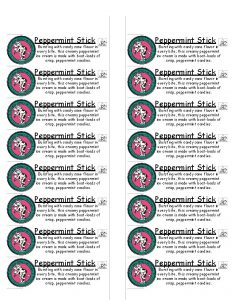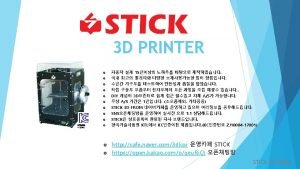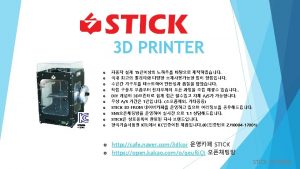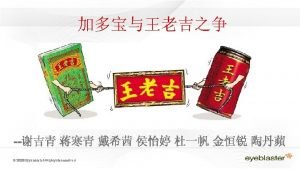STOP STICK Training Proprietary Information All rights reserved
























- Slides: 24

STOP STICK Training Proprietary Information- All rights reserved

Stop Stick® This presentation does not replace the accompanying lesson plans, training video, or practical training. 2| Proprietary Information- All rights reserved

Stop Stick® Deployment of STOP STICKS in the Deployment Sleeve with the retractable Cord Reel attached is the sole recommended method for deployment of STOP STICKS. Any officer authorized to deploy STOP STICKS must be properly trained in this deployment method. You or others can be killed or seriously injured if you don’t follow safety messages. 3| Proprietary Information- All rights reserved

LEARNING OBJECTIVES 1. Describe the basic construction of STOP STICK. 2. State, orally or in writing, the recommended surface for successful deployment of STOP STICKS. 3. State, orally or in writing, the primary recommended method of deployment. 4. State, orally or in writing, the safety and tactical considerations when deciding to deploy STOP STICKS. 5. State, orally or in writing, the type of vehicles STOP STICKS should NOT be deployed against. 6. State, orally or in writing, the post use replacement/warranty process. 4| Proprietary Information- All rights reserved

STOP STICK® OVERVIEW A STOP STICK is 3 feet (91 cm) in length and weighs 1. 1 pounds (0. 516 kg). A STOP STICK is comprised of the following components and sub-assemblies: • • 5| 36 Teflon® coated hardened steel QUILLS; 1 7/8 inches (4. 76 cm) in length, assembled in three rows of 12. 72 Teflon® coated steel SPIKE TIPS, 3/8 inches (0. 95 cm) in length, inserted into each end of all QUILLS. A collapsible polymer CORE , to orient the QUILL/SPIKE TIP assemblies. The polymer CORE, is encased in a TARTAN tape glass filament FRAME, to contain the QUILL/SPIKE TIP assemblies during impact. Proprietary Information- All rights reserved

STOP STICK® OVERVIEW (cont. ) • • A polypropylene HOUSING, to contain the inner subassemblies and to protect the officer from injury while handling the STOP STICK. Accessories: – Reusable nylon SLEEVE 9 ft (3 sticks) or 12’ (4 sticks). – CORD REEL with 80 feet (24 m) of 150 pound (68 kg) test braided polyester cord. – MOUNTING TRAY, designed for trunk mounting with reflective STOP STICK sticker. – Optional: Zip up carrying bag. • Two WARNING LABELS appear on each STOP STICK. – Be sure to READ AND FOLLOW all safety messages on-product and in this lesson! 6| Proprietary Information- All rights reserved

STOP STICK USE ALWAYS follow the policies and procedures of your Agency when deploying STOP STICKS. STOP STICK training materials are intended to supplement the formal Pursuit Policy of your agency. Stop Stick, Ltd. recommends that these “Guidelines For Use” be incorporated into your agency’s written Standard Operating Procedures (SOP). However, the training, policies, and procedures of your agency – including when and how to deploy STOP STICKS – supersede any written or verbal instructions from Stop Stick, Ltd. 7| Proprietary Information- All rights reserved

BEFORE DEPLOYING STOP STICK Before deciding to deploy STOP STICKS, many factors must be considered. The following are some important safety and tactical issues to think about. The circumstances of each pursuit are very different, but safety is always the most important factor. Suspects can abruptly swerve, stop, or otherwise maneuver their vehicle in an unexpected manner while attempting to avoid STOP STICKS. Safety Considerations: • • ALWAYS plan ahead for pursuits in your area. Be prepared to find substantial cover in the location. – A large tree, guard rail, or other object or sufficient structure capable of stopping an approaching vehicle. – Patrol vehicles are not adequate cover. • ALWAYS avoid deploying STOP STICKS in locations or situations that limit the ability of the fleeing suspect to safely maneuver their vehicle. Under some circumstances, tire deflation can increase the possibility that a driver may lose control of the vehicle and crash, resulting in SERIOUS or FATAL INJURIES. 8| Proprietary Information- All rights reserved

BEFORE DEPLOYING STOP STICK (cont. ) LIMIT TRAFFIC on the roadway. Heavy or congested traffic increases the chance of an accident, resulting in injury or property damage. Whenever possible, limit or isolate traffic from the pursuit or location where STOP STICK is being deployed. RESTRICT PEDESTRIANS. Bystanders, observers and other pedestrians in the surrounding area are especially vulnerable to injury if they are struck by a vehicle. NEVER deploy STOP STICK with pedestrians in the immediate vicinity. NEVER use STOP STICKS on vehicles with fewer than four wheels. Vehicles such as motorcycles and 3 -wheeled ATVs are less stable and persons driving these vehicles are more likely to lose control when their tires deflate. To reduce the risk of serious or fatal injuries resulting from a vehicle crash, use EXTREME CAUTION when: – Pursuits reach EXCESSIVE SPEEDS. – Fleeing suspects appear to be under the influence of DRUGS or ALCOHOL. ONLY deploy STOP STICKS when you have a safe location to observe the target vehicle. You could be struck if suspects unexpectedly swerve, stop, or lose control of their vehicle. You must be able to safely observe the target vehicle and other traffic. 9| Proprietary Information- All rights reserved

BEFORE DEPLOYING STOP STICK (cont. ) Tactical Considerations: • Remember to plan ahead for the use of STOP STICKS. – Determine the best locations for deployment and know where protection exists. AVOID deploying STOP STICKS on wet surfaces, gravel or loose pavement. These surfaces may increase the risk a person will lose control of the target vehicle when tires deflate. – Consider deploying STOP STICKS so that a suspect has limited ability to avoid striking the device. – When deploying near an intersection, consider deploying before the intersection to limit the ability of the suspect to avoid STOP STICKS. – ONLY deploy STOP STICKS after you have identified a SAFE LOCATION to observe the pursuit. ALWAYS move to a SAFE LOCATION after deploying STOP STICKS. – The cord reel has 80 ft. (24 m) of cord to allow you to move as far as possible from the road so that you can avoid fleeing or pursuing vehicles. 10 | Proprietary Information- All rights reserved

DEPLOYING STOP STICK ALWAYS advise pursuing units when and where STOP STICKS are being deployed. – Provide fellow officers with ample warning to avoid striking the device. Pre-Load is the sole recommended method of deployment. Pre-load three or four unconnected STOP STICKS in the supplied nylon sleeve; with the cord reel attached to the end of the sleeve. Then place the loaded sleeve in the mounting tray or storage bag until needed. 11 | Proprietary Information- All rights reserved

DEPLOYING STOP STICK Pre-Load Deployment Method 1. Remove the sleeved STOP STICKS from the mounting tray or storage bag. 2. Unlock the cord reel. When all lanes of traffic are clear, use the red handles to throw the sleeved STOP STICKS to the opposite side of the road. 12 | Proprietary Information- All rights reserved

DEPLOYING STOP STICK 3. Communicate to the pursuing officers that the STOP STICKS are in position and the location. 4. Once the sleeved STOP STICKS are on the opposite side of the road (grass, shoulder, median, etc. ), position yourself in a safe location for the impending deployment, while using your peripheral vision to monitor approaching traffic. 13 | Proprietary Information- All rights reserved

DEPLOYING STOP STICK 5. Lock the cord reel and hold it by the handle while awaiting the target vehicle. NEVER wrap the cord around your hand or any portion of your body. 6. As the target vehicle approaches, carefully step backward with the cord reel in hand, to pull the sleeved STOP STICKS into the path of the target vehicle. NEVER rush a deployment. 14 | Proprietary Information- All rights reserved

DEPLOYING STOP STICK 7. After the sleeved STOP STICKS have been struck, remove them from the roadway by pulling the cord reel. ALWAYS use caution when removing STOP STICKS from the road. DO NOT enter the roadway if pursuing vehicles have not passed. Handle carefully, STOP STICKS may break open. Always follow the policies and procedures of your agency when deploying STOP STICKS. Those policies and procedures supersede any written or verbal instructions from Stop Stick, Ltd. 15 | Proprietary Information- All rights reserved

DEPLOYING STOP STICK Example of Improper Deployment 16 | Proprietary Information- All rights reserved/ Video Clip from IACP “Safe Deployment of Tire Deflation Devices”

DEPLOYING STOP STICK What was wrong? – NEVER use a vehicle as cover. – NEVER enter the roadway to deploy STOP STICKS. – ALWAYS deploy STOP STICKS to the other side of the roadway and pull them into roadway at the last moment. – ALWAYS move to a SAFE LOCATION after deploying STOP STICKS. 17 | Proprietary Information- All rights reserved

DEPLOYING STOP STICK Example of Improper Deployment 18 | Proprietary Information- All rights reserved/ Video Clip from IACP “Safe Deployment of Tire Deflation Devices”

DEPLOYING STOP STICK What was right? – Communication between deploying and pursuing officers that STOP STICKS are in position and the location. What was wrong? – NEVER enter the roadway to deploy STOP STICKS. – NEVER rush a deployment. – LIMIT TRAFFIC on the roadway. 19 | Proprietary Information- All rights reserved

DEPLOYING STOP STICK Example of Improper deployment 20 | Proprietary Information- All rights reserved/ Video Clip from IACP “Safe Deployment of Tire Deflation Devices”

DEPLOYING STOP STICK What was right? – ALWAYS move to a SAFE LOCATION after deploying STOP STICK. What was wrong? – PULL STOP STICK into the roadway at the last possible minute. – NEVER wrap the cord around your hand or any other body part. 21 | Proprietary Information- All rights reserved

AFTER DEPLOYING STOP STICK • If STOP STICKS were struck by any vehicle: – The device is no longer fully functional and should be replaced as soon as possible. – Go to stopstick. com/home/pursuit-reporting and fill out the “Pursuit Reporting Form”. – If you have any questions about replacement(s), contact Stop Stick, Ltd. at 513 202 5500. • If STOP STICKS were not struck by any vehicle: – Inspect the sleeved STOP STICKS for damage. – If undamaged, return sleeved STOP STICKS to the tray or storage bag, for the next deployment situation. 22 | Proprietary Information- All rights reserved

CARE AND MAINTENANCE With reasonable care, your STOP STICKS will be ready to aid you in preventing or terminating a pursuit that creates a hazard to you and the public. Follow these simple guidelines to ensure your STOP STICK are ready for use: • Periodically inspect STOP STICKS to ensure they are undamaged and ready for deployment. • When STOP STICKS are stored in the tray or storage bag, be sure other items in the trunk are not interfering with STOP STICKS. Either STOP STICKS could be damaged or the STOP STICKS could potentially damage an item it impacts. 23 | Proprietary Information- All rights reserved

CONCLUSION Installation of STOP STICK in each agency patrol vehicle provides a viable alternative to extended vehicle pursuits that endanger you, the public, and the fleeing suspect. Risk Management experts say that the greater risk to our safety and those around us occurs while we are doing the most dangerous tasks we are required to do, and when these tasks are things we do the least often. But with the use of on-going training, pre-planning and frequent practice, you may be able to decrease the heightened dangers of high risk/low frequency activities. Practice using STOP STICK so you are ready to deploy them properly when you need to end a pursuit. 24 | Proprietary Information- All rights reserved
 Specification by example
Specification by example Copyright 2015 all rights reserved
Copyright 2015 all rights reserved All rights reserved sentence
All rights reserved sentence Freesound content licence
Freesound content licence Confidential all rights reserved
Confidential all rights reserved Sentinel-controlled loop pseudocode
Sentinel-controlled loop pseudocode Copyright 2015 all rights reserved
Copyright 2015 all rights reserved 2012 pearson education inc
2012 pearson education inc Microsoft corporation. all rights reserved.
Microsoft corporation. all rights reserved. Microsoft corporation. all rights reserved.
Microsoft corporation. all rights reserved. Microsoft corporation. all rights reserved
Microsoft corporation. all rights reserved Pearson education inc. all rights reserved
Pearson education inc. all rights reserved Dell all rights reserved copyright 2009
Dell all rights reserved copyright 2009 Warning all rights reserved
Warning all rights reserved Siprop
Siprop All rights reserved formula
All rights reserved formula Warning all rights reserved
Warning all rights reserved Confidential all rights reserved
Confidential all rights reserved Microsoft corporation. all rights reserved
Microsoft corporation. all rights reserved 2010 pearson education inc
2010 pearson education inc Copyright © 2018 all rights reserved
Copyright © 2018 all rights reserved Gssllc
Gssllc Copyright 2010 pearson education inc
Copyright 2010 pearson education inc 2010 pearson education inc
2010 pearson education inc Confidential all rights reserved
Confidential all rights reserved














































